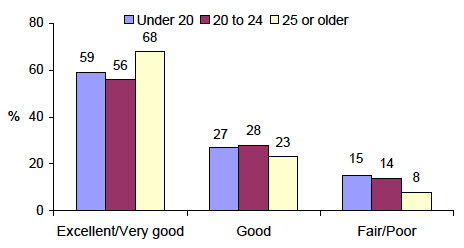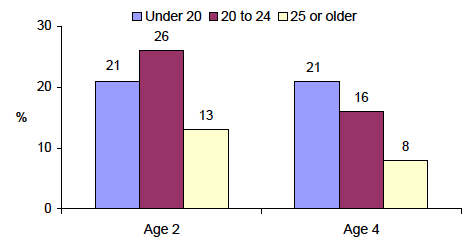The Experiences of Mothers Aged Under 20: Analysis of Data From the Growing up in Scotland Study
Analysis of Growing Up in Scotland data on the circumstances of first-time mothers in Scotland who were aged under 20 at the time of the child’s birth. Data collected up to the child’s sixth birthday were used to compare these circumstances with those of mothers who were aged 20 to 24 and aged 25 or older at the time of their child’s birth.
4 Maternal Health
Introduction
4.1 GUS collects information on parents' general health and long-standing illness at every contact. In addition, on a less frequent basis, information is also collected on parents' physical and mental wellbeing and on certain health-related behaviours such as smoking, drinking alcohol and using illicit drugs. This chapter compares differences in these characteristics for mothers of different ages.
Key findings
- Mothers aged under 20 and those in their early twenties rated themselves similarly in relation to general health and mental wellbeing. On each of these measures, they reported poorer health than those aged 25 or older. Notably, those in their early twenties were the group most likely to report poor physical wellbeing and high depression and anxiety.
- In terms of perceived general health there was little change in the difference between groups over time. When the child was aged six, mothers aged under 25 remained more likely than older mothers to rate their health more poorly.
- There were no differences by maternal age in the prevalence of longstanding health conditions when the child was aged two. However, by age six, whilst prevalence had increased for mothers in all age groups, it had done so more sharply for mothers aged under 20 making them most likely to have such a condition at this stage.
- Smoking was more common amongst mothers aged under 20 than those in other age groups. Prevalence amongst mothers aged under 20 and those in their early twenties was relatively similar and quite distinct to that amongst mothers aged 25 and over.
- Patterns of alcohol consumption were different. Whilst mothers in all age groups were just as likely to drink alcohol, those aged 25 and older tended to do so more frequently but to consume fewer units when they did. In contrast, mothers aged under 20 tended to drink less often but consume more units. Those in their early twenties fell somewhere in between.
- Mothers in all age groups were also similarly likely to have ever taken drugs but those aged under 25 were more likely than older mothers to have done so in the last year.
General health
4.2 Mothers were asked to rate their general health as 'excellent', 'very good', 'good', 'fair' or 'poor'. The data in Table 4.1 and Figure 4-A show that, when the child was aged 10 months, the majority of mothers (around 90%) said their health was excellent, very good or good. A significant relationship was found, however, between age and perceived general health. A larger proportion of mothers aged under 25 (both under 20 and aged 20 to 24) than those aged 25 and over assessed their health as fair or poor (around 15% for those aged under 20 and aged 20 to 24 compared with 8% for those aged 25 or older) whilst a lower proportion said their health was excellent (19% of mothers aged under 20 and 21% of those aged 20 to 24 compared with 26%). Mothers aged under 20 and those in their early twenties were very similar on this measure.
Figure 4-A Mothers' perceived general health when child was aged 10 months, by maternal age at child's birth

4.3 Table 4.2 illustrates how mothers assessed their own general health when the child was aged two, four and six. Similarly to the data at 10 months, most mothers, at all age points and in all age groups, reported that their health was either 'excellent' or 'very good'. However, the proportion reporting 'excellent' or 'very good' health reduced for each age group between ages two and six: from 51% to 43% for mothers aged under 20; 53% to 41% for those in their early twenties and 64% to 56% for the older mothers. With this consistent change, younger mothers' lower likelihood of reporting 'excellent' health was maintained. The likelihood of mothers aged under 20 reporting poor health increased slightly over time from 2% to 5% by age four and 8% by age six. In contrast, the proportion for older mothers remained largely static at around 2%.
Health problems and disabilities
4.4 The poorer health of mothers aged under 20 when the child is older is also evident in Table 4.4. The data here demonstrate how mothers aged under 20 were more likely than older mothers to develop a longstanding health problem or disability by the time the child was aged six. Around 15% of mothers in all age groups reported a longstanding health condition when the child was aged two. However, by age six, this had increased to 25% of mothers aged under 20, compared with 17% of those in their early twenties and 19% of mothers aged 25 or older.
Physical and mental wellbeing (SF12)
4.5 Health-related quality of life was measured using the Medical Outcomes Study 12-Item Short Form (SF-12). The SF-12 provides two summary scale scores: a physical component (PCS) and a mental component (MCS). Higher summary scale scores are indicative of better health-related quality of life. However, as the results are based on the mothers self-reported own physical and mental functioning they are subjective and may lead to differential reporting between respondents with an equivalent objective health status. The SF-12 does not have threshold scores defining whether or not an individual is likely to be suffering from a psychiatric disorder or physical health problem. For this reason poor maternal mental health and physical health is defined in terms of an individual's score in relation to the average score for all first-time mothers in the sample. A score of one standard deviation below the average was used as a cut-off for both scales for to indicate relatively poor physical and mental health. Table 4.5 shows the results by age for physical wellbeing.
4.6 The vast majority of mothers reported good physical wellbeing. However, mothers in their early twenties were those most likely to have poor physical wellbeing (15%) followed by mothers aged under 20 (10%) and those aged 25 and over (8%).
4.7 Poor mental wellbeing was more common than poor physical wellbeing (14% compared with 10%). Trends by maternal age were similar, showing younger mothers to have lower mental wellbeing than older mothers (Table 4.6). 19% of mothers aged under 20 and 18% of mothers in their early twenties reported poor mental wellbeing compared with 12% of mothers aged 25 and above.
4.8 At ages two and four selected items from the depression and stress components of the Depression, Anxiety and Stress Scale (DASS) were included in the questionnaire (Lovibond & Lovibond, 1995). The DASS score is a more symptomatic measure of mental health than the mental component of the SF-12. As with the SF-12, poor mental health was defined using the individual's score relative to the average score of all mothers. Those mothers whose score was one standard deviation above the average were defined as having poor mental health.
4.9 Table 4.7 and Figure 4-B shows the distribution of poor mental health by age group at ages 2 and 4. At age two, mothers aged under 20 had poorer mental health than the oldest mothers (21% compared with 13% mothers aged 25 or older), though those in their early twenties were most likely to show poor mental health. By age four, there was no change in the proportion of mothers aged under 20 reporting poor mental health, whilst for both other age groups the proportion decreased - quite considerably for mothers in their early twenties. Consequently, by age four the gap between the proportion of mothers aged under 20 and older mothers with poor mental health had widened.
Figure 4-B % of mothers' with poor mental health when child was aged 2 and 4 years, by maternal age at child's birth

Smoking, alcohol and drugs
4.10 When the child was aged 10 months, mothers aged under 20 were three times more likely to smoke cigarettes than those aged 25 and over (47% compared with 13%, Table 4.8).
4.11 Patterns of alcohol consumption were the opposite - to some extent - and differences between the groups were also smaller. Older mothers reported more frequent drinking (Table 4.9), though drank less on a typical drinking day (Table 4.10). The majority of mothers drank alcohol (82%) and were most likely to do so around once a month (42%). 14% of mothers aged 25 and over drank 2-3 times a week compared with just 2% of mothers aged under 25 years old. However, on a typical drinking day, 53% of mothers aged under 20 and 47% of mothers in their early twenties said they drank five or more units compared with 25% of mothers in the oldest group. Furthermore, 20% of mothers aged under 20 reported drinking more than 10 units on a typical drinking day compared with 2% of the older mothers.
4.12 Mothers were asked if they had ever taken any illegal drugs (Table 4.11). Most (74%) had not. There were no differences by maternal age. However, when asked about drug use in the last 12 months, although 87% of mothers had not used any, some age differences did emerge (Table 4.12). 90% of mothers aged 25 or older had not taken drugs in the last year compared with 82% of those aged under 25. The dominant drug used was cannabis. 17% of mothers aged under 25 said they used cannabis in the last 12 months compared with 7% of older mothers.
Contact
Email: Liz Levy
There is a problem
Thanks for your feedback